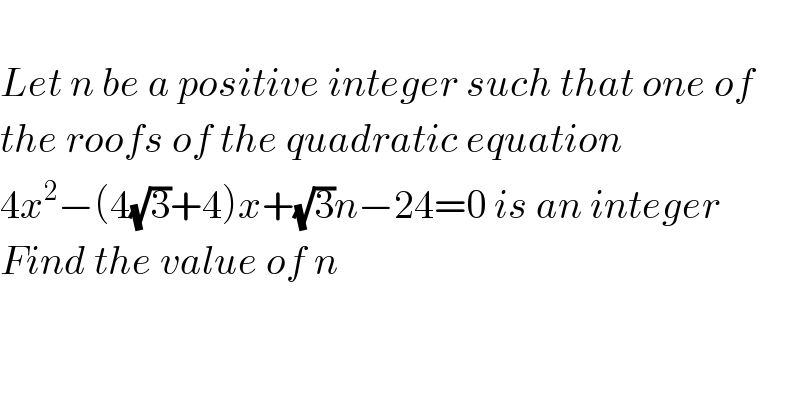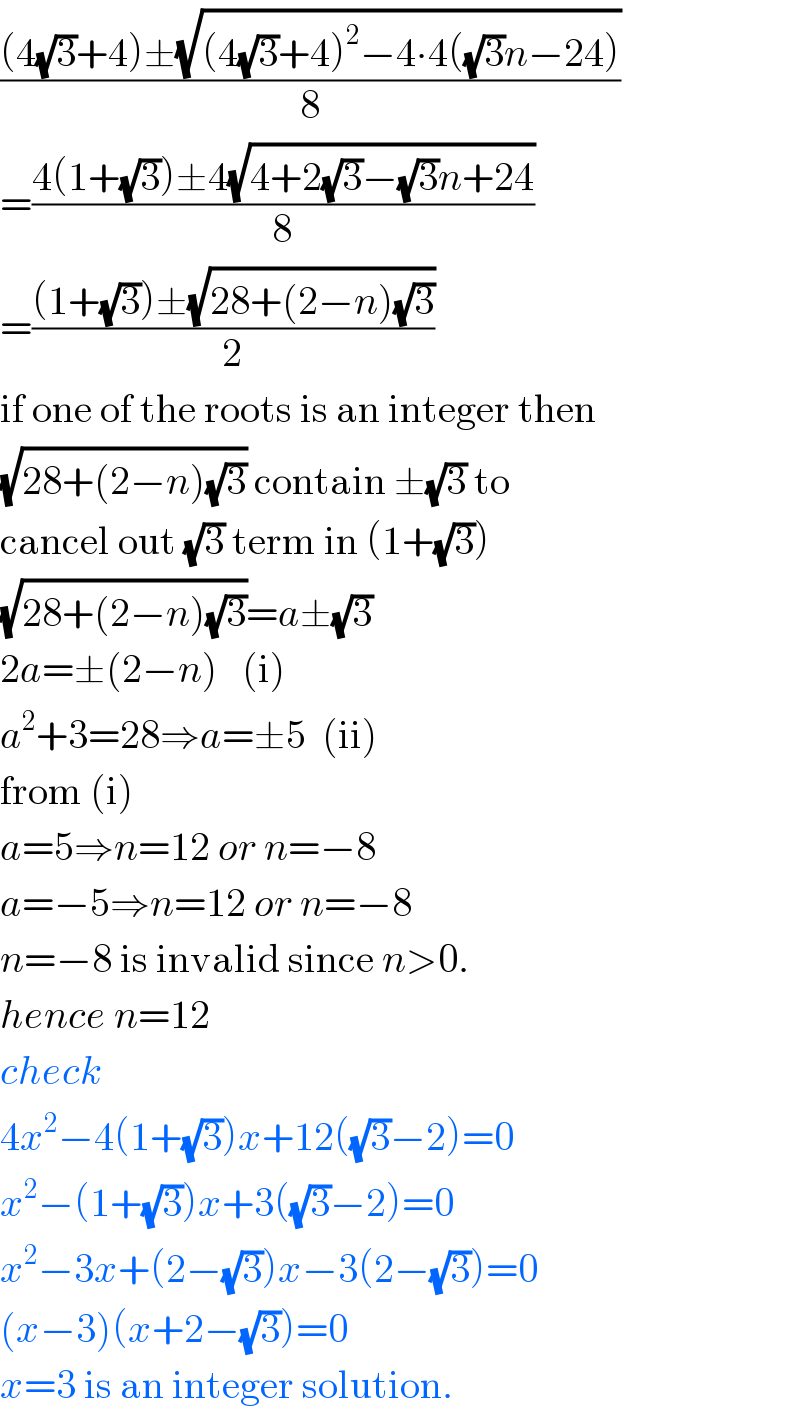Question Number 8957 by Sopheak last updated on 07/Nov/16

$$\: \\ $$$${Let}\:{n}\:{be}\:{a}\:{positive}\:{integer}\:{such}\:{that}\:{one}\:{of} \\ $$$${the}\:{roofs}\:{of}\:{the}\:{quadratic}\:{equation}\: \\ $$$$\mathrm{4}{x}^{\mathrm{2}} −\left(\mathrm{4}\sqrt{\mathrm{3}}+\mathrm{4}\right){x}+\sqrt{\mathrm{3}}{n}−\mathrm{24}=\mathrm{0}\:{is}\:{an}\:{integer}\: \\ $$$${Find}\:{the}\:{value}\:{of}\:{n}\: \\ $$$$\: \\ $$
Commented by prakash jain last updated on 07/Nov/16

$$\frac{\left(\mathrm{4}\sqrt{\mathrm{3}}+\mathrm{4}\right)\pm\sqrt{\left(\mathrm{4}\sqrt{\mathrm{3}}+\mathrm{4}\right)^{\mathrm{2}} −\mathrm{4}\centerdot\mathrm{4}\left(\sqrt{\mathrm{3}}{n}−\mathrm{24}\right)}}{\mathrm{8}} \\ $$$$=\frac{\mathrm{4}\left(\mathrm{1}+\sqrt{\mathrm{3}}\right)\pm\mathrm{4}\sqrt{\mathrm{4}+\mathrm{2}\sqrt{\mathrm{3}}−\sqrt{\mathrm{3}}{n}+\mathrm{24}}}{\mathrm{8}} \\ $$$$=\frac{\left(\mathrm{1}+\sqrt{\mathrm{3}}\right)\pm\sqrt{\mathrm{28}+\left(\mathrm{2}−{n}\right)\sqrt{\mathrm{3}}}}{\mathrm{2}} \\ $$$$\mathrm{if}\:\mathrm{one}\:\mathrm{of}\:\mathrm{the}\:\mathrm{roots}\:\mathrm{is}\:\mathrm{an}\:\mathrm{integer}\:\mathrm{then} \\ $$$$\sqrt{\mathrm{28}+\left(\mathrm{2}−{n}\right)\sqrt{\mathrm{3}}}\:\mathrm{contain}\:\pm\sqrt{\mathrm{3}}\:\mathrm{to} \\ $$$$\mathrm{cancel}\:\mathrm{out}\:\sqrt{\mathrm{3}}\:\mathrm{term}\:\mathrm{in}\:\left(\mathrm{1}+\sqrt{\mathrm{3}}\right) \\ $$$$\sqrt{\mathrm{28}+\left(\mathrm{2}−{n}\right)\sqrt{\mathrm{3}}}={a}\pm\sqrt{\mathrm{3}} \\ $$$$\mathrm{2}{a}=\pm\left(\mathrm{2}−{n}\right)\:\:\:\left(\mathrm{i}\right) \\ $$$${a}^{\mathrm{2}} +\mathrm{3}=\mathrm{28}\Rightarrow{a}=\pm\mathrm{5}\:\:\left(\mathrm{ii}\right) \\ $$$$\mathrm{from}\:\left(\mathrm{i}\right) \\ $$$${a}=\mathrm{5}\Rightarrow{n}=\mathrm{12}\:{or}\:{n}=−\mathrm{8} \\ $$$${a}=−\mathrm{5}\Rightarrow{n}=\mathrm{12}\:{or}\:{n}=−\mathrm{8} \\ $$$${n}=−\mathrm{8}\:\mathrm{is}\:\mathrm{invalid}\:\mathrm{since}\:{n}>\mathrm{0}. \\ $$$${hence}\:{n}=\mathrm{12} \\ $$$${check} \\ $$$$\mathrm{4}{x}^{\mathrm{2}} −\mathrm{4}\left(\mathrm{1}+\sqrt{\mathrm{3}}\right){x}+\mathrm{12}\left(\sqrt{\mathrm{3}}−\mathrm{2}\right)=\mathrm{0} \\ $$$${x}^{\mathrm{2}} −\left(\mathrm{1}+\sqrt{\mathrm{3}}\right){x}+\mathrm{3}\left(\sqrt{\mathrm{3}}−\mathrm{2}\right)=\mathrm{0} \\ $$$${x}^{\mathrm{2}} −\mathrm{3}{x}+\left(\mathrm{2}−\sqrt{\mathrm{3}}\right){x}−\mathrm{3}\left(\mathrm{2}−\sqrt{\mathrm{3}}\right)=\mathrm{0} \\ $$$$\left({x}−\mathrm{3}\right)\left({x}+\mathrm{2}−\sqrt{\mathrm{3}}\right)=\mathrm{0} \\ $$$${x}=\mathrm{3}\:\mathrm{is}\:\mathrm{an}\:\mathrm{integer}\:\mathrm{solution}. \\ $$
